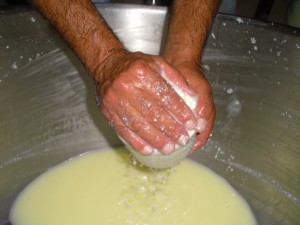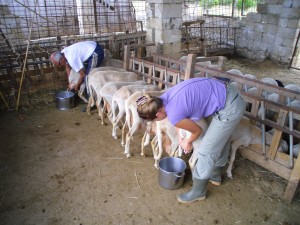
Someday I’ll learn the words so next time I can sing along. [Stirring the curds for some of the most amazing cheese ever!]
Domenico sings Italian love songs as he works. Loudly. Passionately. He began milking sheep about forty years ago. He’s from Sardinia (Italian island) , where his ancestors started milking sheep centuries ago. He is still using the same method: capture a sheep, hold it in place with your knees, bend forward to obtain clear view of udder, milk sheep, immediately make cheese with milk collected. Repeat in the afternoon.
Milking a sheep isn’t easy. One might imagine an udder as a giant balloon full of milk. Squeeze the spout (teat) and milk comes out, eh? If only it worked like that.
Nine months ago, in the New Zealand springtime, I was bashed repeatedly in the chin and face by orphaned lambs wwoofing on a farm in Hawke’s Bay. The motherless babies need bottle-fed up to six times a day. They adorably and spastically bounce and frolic to anyone who appears bearing bottles. Like a human infant is born with a sucking reflex, lambs seem born with fierce nuzzling reflex. Thanks to the average dimensions of a baby sheep and human torso, this means they accidentally but enthusiastically crash their skull into yours as they search for the bottle nipple in your hand. Little did I know this experience would actually benefit me 263 days and 11,500 miles later.
At milking time — 4:30 a.m. and 3:45 p.m. – the sheep eagerly thrust their heads through the gates of the milking stalls to nibble at the grain that has just been splashed into the communal trough. Domenico runs around and catches all the sheep who couldn’t find a spot, squeezing their hips between his knees and making quick work of the ewe’s half liter (two cups) of milk.
Antonio, 50% partner with Domenico, lives on the farm with Mariangela. His milking style involves a stool. I tried both reaching down from above and sitting behind, but am far more productive with the former style. Here’s more on the specifics for those interested.
So what’s so hard? I coined this metaphor: imagine squeezing every last drop of toothpaste out of a half empty tube one-handed. Essentially, using trial and error, you must get a feel for where on earth the milk is in the udder, force it down toward the teats using a variety of pressure tricks and hand contortions, and somehow make sure all your efforts culminate in a blast of milk out of the teat. When I was totally green, 90% of the time the finale was about three drops. If I was really lucky, a pathetic, half-hearted trickle of milk. At then end of five days, I’d cut my time per sheep in half — from about 10 minutes to sometimes under five. (Domenico and Antonio take about 20-40 seconds).
After the fun of milking comes “How to Make Pecorino Cheese!” Serendipitously, we arrived during the change from two types of winter cheese to one type of summer cheese: I got to see all three recipes in action. For those of you questioning the sanity of eating cheese from sheep’s milk — I would enthusiastically encourage your skepticism. More cheese for ME! The three cheese-making recipes are here. For now, it shall suffice to say that — like many cheese recipes — milk is heated, then cooled a bit, then mixed with a small amount of rennet, allowed to sit until curds form, then skillfully scooped into baskets that allow much of the whey to drain away. After a day, often the outside is salted to start the preservation and aging process. Sometimes it’s consumed the day after it’s created. If not, it enters a cycle of daily turning in a cool, slightly humid place until it’s time to enjoy!
I loved wwoofing at Domenico, Antonio, and Mari’s farm. The night we arrived, Antonio was DJ-ing at his friend’s bday party, and Domenico was in charge of roasting the birthday sheep on a spit. I had a blast dancing, practicing my novice Italian, breaking out my much-better Spanish, and eating the most delicious roasted meat I’ve ever tasted. Even the most anti-mutton carnivore would dissolve in bliss: I swear.
Other farm jobs of interest: picking capers, processing oregano, butchering chickens, and mucking out the milking area. Until a Balinese farm tour, I never knew where cloves came from; and, until wwoofing in Italy, I never knew where capers came from. Like cloves, they are also flower buds. They are picked, put in rock salt for five days, put in new rock salt for five more, then stored in a jar under a layer of rock salt or in vinegar for at least 30 days. After that, these little flavor bombs can be added sparingly to pizza, pasta, eggs… anything!

Look closely along the stem and you can see capers as we know them. On the left – a bud that’s been allowed to bloom. Beautiful on the plate and in the garden!
The oregano and mucking out were fairly straight-forward. With the former, the whole plant is hung to dry; then the leaves are stripped, crushed, and jarred. With the latter, in the summer the accumulated poo needs hauled away once a day. Homemade brooms work quite well to sweep the dung into piles which are shoveled into the wheelbarrow. The best part of the whole job was listening to our fellow German wwoofing couple and Antonio use the word “shit” in a very cavalier way. It’s not vulgar to them like it is for an American. “We need to get one more shit (“sheet”) pile over there,” and “When it’s full, we take the other shit (“sheet”) to the field,” are just a few of the many phrases that rolled off their tongues.

Sorry if you’ve got a weak stomach, but I thought this was awesome to see. The egg is in Pat’s hand.
The chicken butchering was interesting in that, while I’ve butchered many a chicken, I’ve never seen what’s inside. Examining the inner-workings of an egg factory was very cool. Each chicken had a fully formed egg inside waiting to be laid, along with two to three full sized yolks, and dozens (ha!) of tiny eggs-to-be ranging in size from peppercorn to pea.
Two other fascinating farm lessons: falcon fending and pasta processing. Mari and Antonio’s neighbor and friend Giuseppe grows his own grain which he sells as pasta. To my surprise — and supposedly this is very common in Italy — he doesn’t actually do any of the work in between harvesting and selling the product. He hauls the grain to his nearby mill. They return bags of flour which he drives several hundred kilometers to his favorite pasta maker who turns out several boxes of varying styles of packaged pasta! Mari and Antonio also have a friend who gets paid to hang out at the airport all day. His job? Pigeon prevention. He keeps falcons — very territorial birds — that will apparently defend their master’s space. He’s helping Antonio train a falcon to protect the sheep farm (and orchard and garden) from other birds, and we got to watch the bird lessons every day. Awesome!
Final cool farm animals: the barn kittens! Tiny and not yet skittish, these little bundles of stumbling fur were a highlight of every day. What with cute kittens, fascinating falcons, heavenly capers, and savory cheese, I could have spent months in Lecce. ♣
Adorable baby kittens, the heavenly cheese aging room, and a fig the size of my fist in this facebook album.









Hi Jema, I am researching an Italian travel show for Australian TV and I love your blog! Would you mind checking your facebook messages from other so we can be in touch?
Thanks so much, Melissa
Man, milking the whole udder in 40 seconds? Still takes me about 5 -10 minutes…then again I only do one side at a time and hold a jar with my other hand. Still….how do they do it?! If I squeeze too high in the udder my girls start kicking and dancing (thus why i hold a jar and don’t put a bucket behind them).
Erika! Hi! Thanks for stopping by. Do you do the milk-from-behind method or straddle-and-milk-from-above? I can only speak to the latter – had much more success that way. I can imagine squeezing too high up would make the ladies uncomfortable, but what I found was being able to press the udder up into the body increased the pressure enough to create a significant stream. Domenico also told me it was best to relieve the pressure evenly (i.e. to do a few squirts one side, a few squirts the other if you’re only doing to do one side at a time). Hope that helps! Buena suerte!